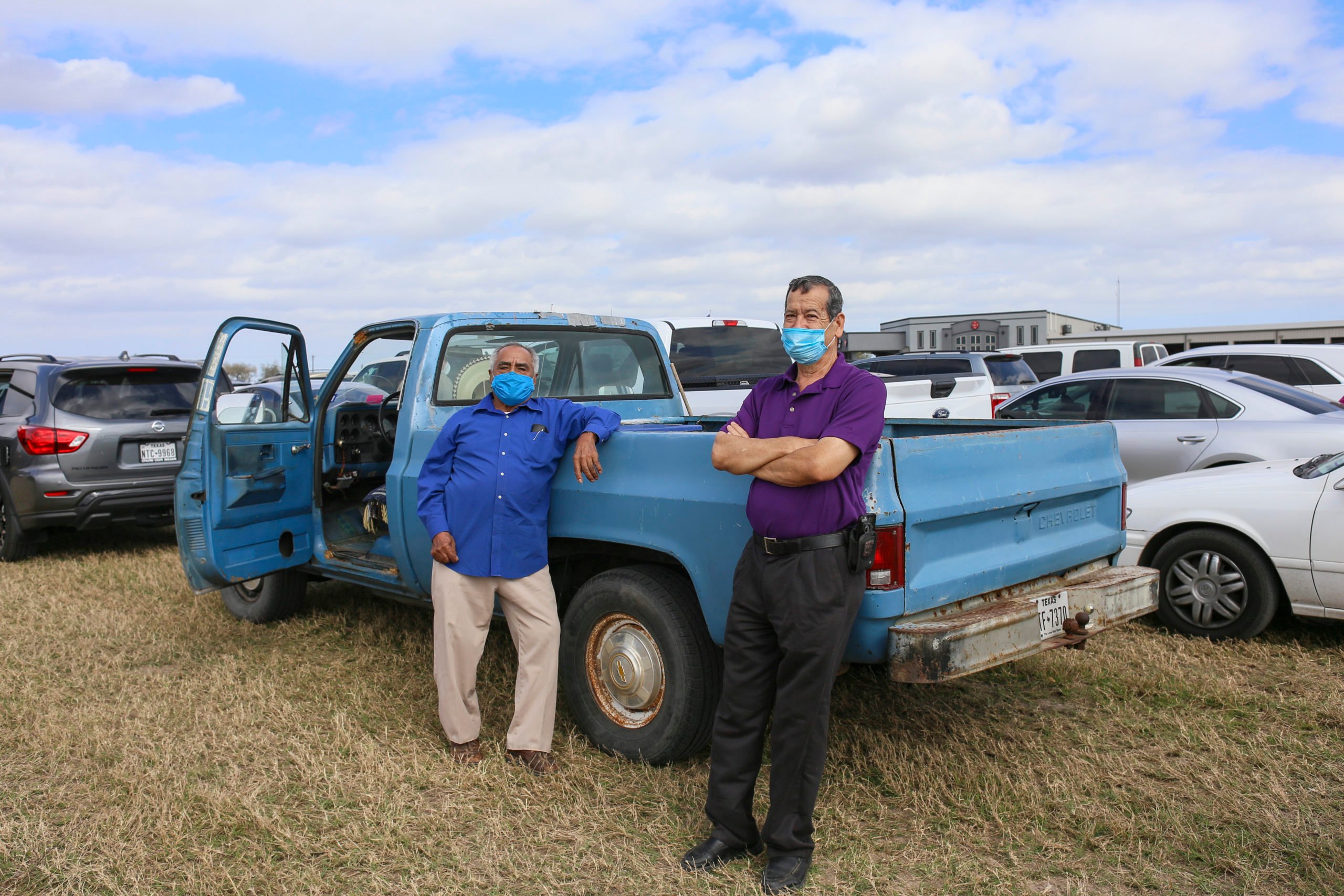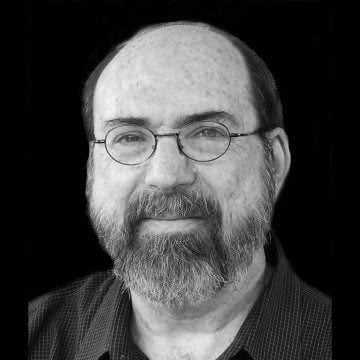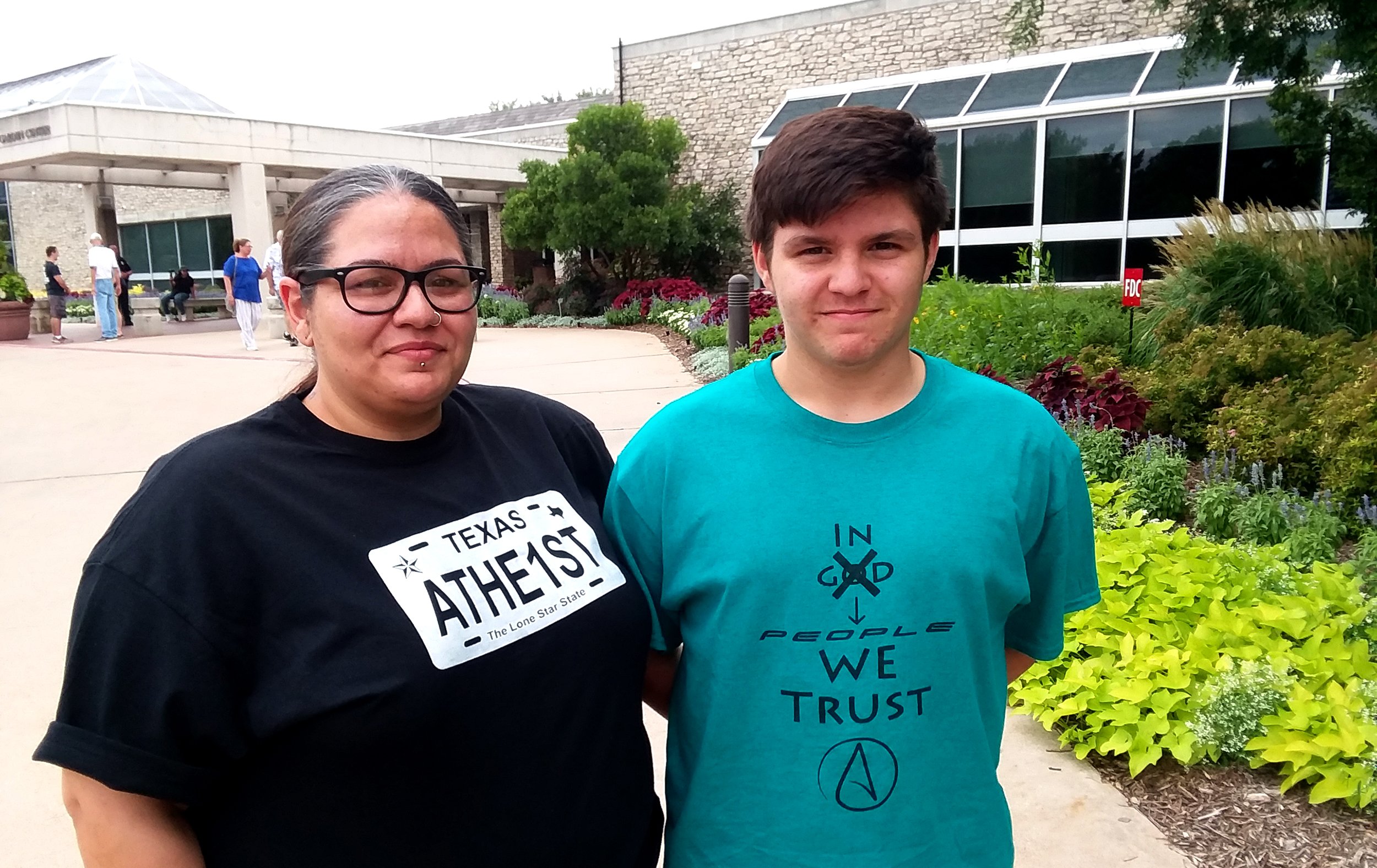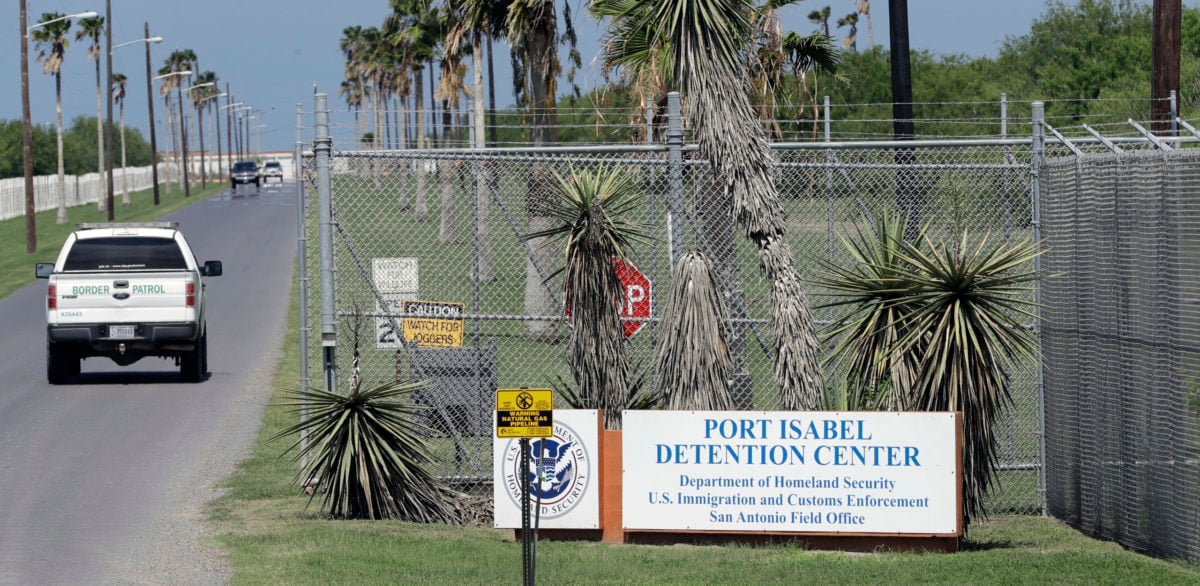
Editorial: Texas Wasn’t Prepared for the Statewide Vaccine Rush
My elderly parents’ experience getting the COVID-19 vaccine highlights problems with Texas’ overall pandemic response.

Above: Amador Moreno and Tony Holguin wait in the second to last stretch of the line on January 29 to receive the COVID-19 vaccine at the Los Fresnos Fire Station & EMS in Los Fresnos, Texas. At a little after 2 p.m. the two had already been waiting for three hours and expected to wait for another three hours.
When my parents, Joe and Zelma Brockman, arrived at a Grand Prairie clinic for their first dose of the COVID-19 vaccine, they were expecting a wait. They’d driven by a couple days earlier and seen a long line out front. So on January 4, they went to Purple Hearts Primary Care Services first thing in the morning, trying to beat the rush. But when they arrived just after it opened at 9 a.m., a line already stretched from the entrance, past neighboring businesses in the strip shopping center, and around to the back of the building. Some people had been there since 6:30 a.m.
The wait dragged on for two hours, then three. It was a chilly morning, and my folks were bundled in coats and gloves as they stood in the building’s shadow. Around noon, standing in the direct sun, they had to shed their coats. They hadn’t brought anything to drink or snack on. There were no available restrooms. At one point, a nurse told people to stop using those in neighboring businesses, as the owners had complained to the shopping center landlord.
Eventually, the heat and all that standing got to my mom, who is 86. She passed out.
Dad, 93, managed to break her fall as she crumpled. The nurse rushed over. Fortunately, Mom came away with only a bruise. When she was able to stand again, the nurse had my parents wait in their car with the air conditioning on; she would get them when it was their turn. Finally, around 3 p.m., they were admitted inside. Six hours after they arrived, my parents received their first dose of the Moderna vaccine and a card telling them to return to do this all again for the second dose in early February. Purple Hearts couldn’t be reached for comment. Mom, though rattled by the experience, says she doesn’t blame the clinic: “We just weren’t prepared.”
Elderly folks should never be expected to wait in line, on their feet, for hours. And it’s increasingly clear that it was Texas leaders who weren’t prepared for the statewide “vaccine stampede” they triggered in late December. That’s when Governor Greg Abbott and state health officials departed from the federal Centers for Disease Control and Prevention (CDC) guidelines and opened vaccine eligibility not only to essential workers but also to those over 65 or at high risk. Suddenly, almost 10 million Texans were eligible. The problem: At that time, only 1.3 million doses were available. Millions of Texans now found themselves facing two hurdles: finding a provider, then waiting in long lines.
Texas receives a certain number of vaccines from the CDC each week, which the Department of State Health Services (DSHS) distributes to providers. County officials and local providers then determine how and when to administer the doses. The result is what the Dallas Morning News called a “patchwork of strategies.” According to DSHS spokesperson Chris Van Deusen, a one-size-fits-all approach won’t work “in a state as large and diverse as Texas.” “Local providers have the most expertise in serving their communities and reaching critical populations in their area, and the best way to do that is going to vary from place to place,” he wrote in an email.
The result of this patchwork is that it’s up to individual Texans to figure out how and where to get the vaccine. That means sorting through a bewildering array of pharmacies, hospitals, and clinics, as well as vaccine hubs—large, centralized, county- or city-run operations—on the DSHS website, then contacting each to set an appointment or get more information. When my parents, who don’t use the internet, learned that the state was opening the vaccine to those 65 and over, they asked me to check where it was available. Purple Hearts was listed on the DSHS site as having 900 doses of the vaccine. When Mom called, she got a recorded message that said no appointment was necessary, and gave times the vaccine would be administered.
Texans are finding all of this very confusing, and stories similar to my parents’ are occurring across the state. The same day my parents got their shots, a local NBC affiliate reported that some North Texans waited as many as four hours in line. Others, “despite having an appointment, were given a ‘rain check’ and asked to return the following day.” The Fort Worth Star-Telegram’s Bud Kennedy tweeted pictures of a seemingly endless line outside a Tarrant County vaccination site, more than an hour before it opened. At a county vaccination site in Los Fresnos, in the Rio Grande Valley, at least one man waited more than 14 hours for the shot. A vaccination event in Houston “was beset by overwhelming demand, technical glitches, long wait times, and traffic.” Meanwhile, some rural Texans are traveling hundreds of miles to get their shots. The vaccine is still not reaching some communities of color, which have been especially hard hit by COVID-19. And some Texas residents who managed to get their first dose are now worried and confused about how to get their second.
According to DSHS, which is overseeing the state’s vaccine rollout, the issue boils down to one of supply and demand. “The pace of vaccination is really dependent on the supply available to us as a state,” Van Deusen wrote in an email. “There is considerably more demand for vaccine than there is supply, so people are trying to find it where they can.”
But the problems run deeper. The experiences of my parents and other Texans show how disorganized not only the state’s vaccine rollout has been, but also its response to the pandemic more generally—a response shaped by the limited-government, individualistic philosophy that Texas leaders embrace. The state’s decentralized, every-person-for-themselves approach, with too many people chasing too few doses, contributed to the run on vaccine providers and the confusion and long lines many experienced.
As I argued in a 2013 book, the limited-government individualism our state leaders embrace often overlooks the ways government regulation can be necessary to promote individual welfare—in this case, public health. Though early on Governor Greg Abbott closed schools and limited public gatherings, he resisted calls from local officials for a statewide lockdown until March 31. Just two weeks later, he began reopening the state, claiming that Texas had shown it can “corral the coronavirus.” For months, Abbott and other Texas Republicans have blocked local governments from issuing stronger COVID-19 restrictions. Despite the fact that the daily new case count topped 15,000 for much of January, Abbott vowed that Texans will see no more lockdowns. Instead, he appears to be banking on the state vaccinating its way out of the crisis. He proclaimed sunnily that with “more vaccinations and increased immunity, normalcy is returning to Texas” in his February 1 State of the State address—one which, political analyst Scott Braddock observed, “had to be done in isolation.” Abbott’s office did not respond to a request for comment on this story.
To be fair, distributing the COVID-19 vaccine throughout Texas is a herculean task, and state leaders have been working to untangle the logistical problems. On January 11, DSHS scaled up the number of large vaccination hubs. The goal, Van Deusen said, is that “people have one place to contact, rather than trying to call every pharmacy in town every week.”
Even conservative firebrand Lieutenant Governor Dan Patrick has called for rethinking the vaccination process. In a January 21 letter to the head of the state’s vaccine allocation panel, he wrote: “Too many Texans are spending long days physically standing in line, calling a phone number repeatedly, and spending hours online, trying in vain to get a vaccination appointment.”
But it’s Peter Hotez, dean of the National School of Tropical Medicine at Baylor College of Medicine, who perhaps said it best: “We had nearly a year to think about vaccines.”
If the federal government is able to fulfill President Biden’s promise to distribute 150 million doses in his first 100 days and create more vaccination sites, the supply problems that have plagued Texas’ effort may ease somewhat. Yet as long as our leaders’ individualistic, anti-regulatory ethos continues to shape the state’s COVID-19 response, Texans should prepare for a long, confusing wait for a return to normal.
In late January, after signing up online, my spouse, Eleanor Forfang-Brockman, received an email saying she was scheduled to receive her first dose of the vaccine between 3 and 5:30 p.m. the following day. (I am not yet eligible.) If she could not make that time, the email warned, she would have to start the application process again. After arriving at 3 p.m., we spent about an hour waiting in our car, creeping slowly toward the vaccination site several blocks away. Then it took another hour of standing in line—with little social distancing, though everyone was masked—before Eleanor received her first Moderna dose. She was handed a card advising her to return for her second in late February; the county would notify her of the day and time.
And my parents? They’re expecting another long wait when they return for their second dose this month. This time, Mom told me, “we’ll take a folding chair. And some Gatorade.”
Read more from the Observer:
-
COVID-19’s Deadly Toll on Texas Workers: As COVID-19 devastates workers unable to stay home, families are left struggling for justice.
-
What to do With a “Tidal Wave” of Texas Wind Turbine Blades: The wind energy industry is struggling to find sustainable solutions for fast-accumulating piles of dead wind turbine blades. So far, all the options come with an environmental price.
-
Exploring the Rise, Fall, and Lingering Trauma of the Death Penalty in Texas: In his new book, journalist Maurice Chammah ties Texas’ embrace of capital punishment to the state’s frontier mythos.


